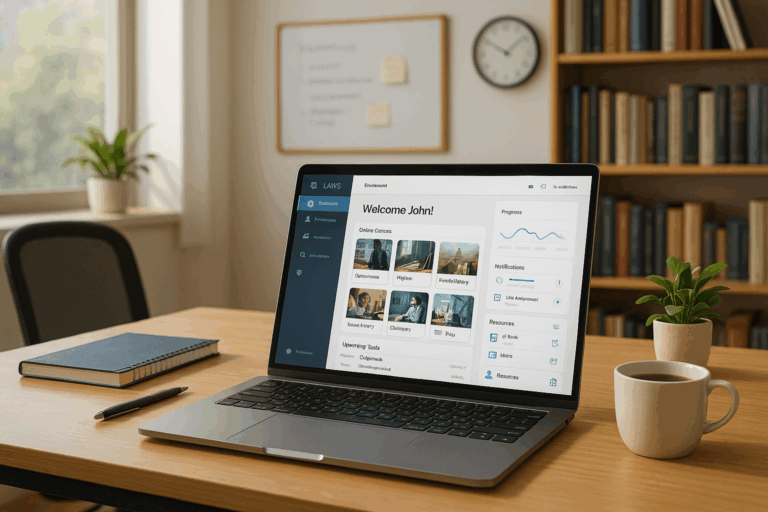Yet, how do we leverage these technological tools to their full potential in fostering student success? The answer lies in how we use them to provide valuable feedback.
Imagine the educational landscape as a garden, the students being the budding plants seeking the sunshine of knowledge, and the LMS as the gardener’s toolkit, equipped with diverse tools, from spades to watering cans, to ensure the growth and flowering of these plants. However, without the proper know-how, the gardener may not fully utilize these tools, and consequently, the plants may not bloom as they should. Similarly, harnessing the power of your LMS for providing valuable feedback can pave the way to maximizing student success. 🚀
This blog post will serve as your comprehensive guide to understanding the role of feedback in the learning process and how to best use your LMS to provide this essential ingredient for academic success.
Why Feedback Matters
Before we delve into the nitty-gritty of the LMS world, it is vital to understand the importance of feedback in education. Feedback is not just about pointing out errors or giving grades; it is about communicating effectively with students regarding their progress, performance, and areas of improvement. Feedback is the compass that guides students through their educational journey. ⚓
The LMS and Feedback: A Powerful Duo
In a traditional classroom setting, providing feedback can be a daunting task, involving laborious manual grading and one-on-one meetings. However, the digital age has blessed us with the LMS – a powerful platform that makes the feedback process more streamlined, efficient, and impactful.
From automatic grading and analytics to discussion boards and personalized feedback tools, an LMS offers a plethora of features that can revolutionize the way you provide feedback. But how can you make the most of these features to enhance student success? This question will be the heart of our discussion as we proceed.
A Sneak Peek into the Journey Ahead
In this extensive exploration, we will first take a look at different types of feedback and their significance in a learning context. We will then move on to understanding the various features of an LMS that facilitate effective feedback.
Further, we will delve into real-world strategies for using your LMS to provide feedback that stimulates learning and fosters student success. Here, we will not only talk about the ‘what’ and ‘why,’ but also the ‘how’ – practical, step-by-step procedures to leverage your LMS for feedback. 💡
The final part of our journey will be dedicated to understanding the challenges associated with LMS-based feedback and finding ways to overcome them. No process is perfect, and being aware of potential pitfalls can help us navigate towards success more smoothly.
So buckle up for this enlightening journey as we dive deep into the ocean of LMS and feedback, uncovering pearls of wisdom that can transform your teaching process and maximize student success. Get ready to harness the power of your LMS to provide valuable feedback – a powerful tool to cultivate a fertile educational landscape where students can bloom and flourish. 🌻
Unlocking the Potential of Your Learning Management System (LMS)
💻 As a stalwart tool in the arsenal of any educational institution, the Learning Management System (LMS) holds significant potential. However, like any tool, the power of the LMS lies in its usage. It is not enough to merely have an LMS; one must know how to effectively harness its power to maximize student success. In the context of education, success is often measured through student feedback. So, how can we leverage the LMS to gain valuable feedback and optimize student outcomes? Let’s dive in.
🧠 The crucial element in utilizing an LMS effectively is understanding its full capabilities. An LMS is more than a digital storage for course materials; it can enable interactive and collaborative learning, track student progress, and provide a platform for feedback. By capitalizing on these functions, you can enhance the educational experience, facilitating more engaged learning and more meaningful feedback.
🔍 Through this article, we will explore how to maximize student success through the strategic use of your LMS, with a specific focus on feedback. To demonstrate this, we will examine various LMS platforms, their features, and how these can be used for feedback. We will also delve into strategies for effective feedback and the role of the LMS in facilitating this.
Comparison of Leading LMS Platforms
Before we can understand how to harness the power of an LMS for feedback, we need to comprehend the capabilities of different LMS platforms. Below is a comparative table of some leading LMS platforms: Moodle, Blackboard, and Canvas.
| LMS Platform | Key Features | Feedback Capabilities |
| Moodle | Open-source, customizable, supports multimedia content, integration with various tools | Grading and feedback tools, online forums, messaging, quizzes, surveys |
| Blackboard | Interactive tools, analytics, content management, mobile learning | Grade Center, performance dashboards, tests, discussions, journals |
| Canvas | User-friendly, mobile app, supports multimedia content, integration with tools | SpeedGrader, rubrics, quizzes, discussions, peer review |
As shown in the table above, each LMS platform has a unique set of features that can be utilized for feedback. However, the specific methods of harnessing these features for valuable feedback will depend on your pedagogical approach and the needs of your students.
Strategies for Effective Feedback
Now that we have an understanding of different LMS platforms and their capabilities, let’s turn our attention to feedback. Feedback is an essential component of the learning process. It provides students with an understanding of their performance and areas for improvement. Effective feedback is timely, specific, constructive, and actionable. The following strategies can help maximize the effectiveness of feedback in an LMS environment.
Utilize LMS Tools for Timely Feedback
One of the significant advantages of an LMS is its ability to automate certain feedback processes. For example, with quizzes or tests, an LMS can automatically grade student responses and provide immediate feedback. This instant feedback allows students to learn from their mistakes in real-time, which can boost their understanding and retention of the material.
Provide Personalized Feedback
While automation can enhance the efficiency of feedback, personalized feedback is crucial for student learning. In addition to automated responses, take the time to provide individualized feedback. This could be in the form of comments on assignments, posts in discussion forums, or direct messages.
Encourage Peer Feedback
Peer feedback is another powerful tool for learning. An LMS can facilitate this through discussion forums or peer review assignments. This not only encourages a sense of community and collaboration among students but also allows them to learn from each other’s perspectives.
Maximizing the Power of LMS through Feedback: Case Studies
Now that we have discussed various LMS platforms and strategies for feedback, let’s look at some real-world examples of how these can be effectively combined to maximize student success.
Moodle: Using Quizzes for Feedback
In a video titled “Using Moodle Quizzes for Formative Feedback” by E-Learning at the University of York, the presenter demonstrates how Moodle’s quiz feature can be used to provide instant, formative feedback. This allows students to understand their mistakes immediately and learn from them. For a detailed look at how this can be done, watch the video here: E-Learning at the University of York – Using Moodle Quizzes for Formative Feedback.
Blackboard: Leveraging the Grade Center for Feedback
Blackboard’s Grade Center offers a platform for instructors to provide detailed, personalized feedback on assignments. By leaving comments on specific parts of an assignment, instructors can guide students towards areas for improvement.
Canvas: Facilitating Peer Review with SpeedGrader
Canvas’s SpeedGrader feature allows instructors to facilitate peer review assignments. Students can leave comments on each other’s work, encouraging peer learning and community building. In the video “Using Canvas for Peer Review Assignments” by Canvas LMS, the presenter demonstrates this feature. For a detailed look at how this can be done, watch the video here: Canvas LMS – Using Canvas for Peer Review Assignments.
Final Thoughts
Ultimately, the key to maximizing student success through your LMS lies in understanding its features and how to use them effectively for feedback. By providing timely, personalized, and peer feedback, you can enhance student learning and engagement, leading to improved outcomes. Remember, the power of the LMS is in your hands. So, harness it wisely.

Conclusion
In closing this comprehensive discussion, it’s essential to reflect upon the salient points explored throughout the article. As a tech-driven society, we’ve delved into the nuances of topics like Information Technology (IT) and engineering, attempting to simplify complex ideas and themes for the common understanding of our specialized audience.
The journey started with a deep dive into the world of software engineering, looking at its basic constructs, the importance, and how it serves as the backbone of modern digital systems 🌐. We then explored the ever-evolving landscape of IT, discussing the latest trends and their implications on today’s business environment. We’ve shed light on the indispensable role of IT in driving operational efficiency, enhancing customer service, and offering strategic advantages 💻.
The discussion further ventured into the intricate details of various specialized fields within IT and engineering, elucidating their specific roles and contributions to the larger tech ecosystem. We’ve dissected their interrelationships and how they collectively enable the smooth functioning of our digitally interconnected world.
Reflecting upon these discussions, it’s apparent how IT and engineering have revolutionized our way of life, from simplifying daily tasks to facilitating complex business operations. Yet, it’s equally important to understand that these fields are constantly evolving, making it essential for us to keep pace with these changes. That’s why we’ve strived to provide you with comprehensive, up-to-date information, blending technical accuracy with simplicity for your understanding 📚.
We firmly believe that the knowledge and insights shared through this article would serve as a valuable resource, enhancing your understanding and shaping your perspectives on these complex topics. But learning is a two-way street. We encourage you to share your thoughts and insights in the comments section below. Your feedback would not only help us refine our content but also facilitate a broader discussion benefiting all readers 👥.
Moreover, if you found the article informative and engaging, don’t forget to share it within your network. Spreading knowledge is a way to empower others, and who knows, your share might just be the spark someone needs to dive into the fascinating world of IT and engineering 👍.
As we conclude, we hope this article has added value to your reading time and inspired you to explore these subjects further. Remember, the more we share, the more we have. So, let’s keep learning, keep sharing, and together, let’s make the world a better, more informed place 🌍.
For more information, you may wish to consult the following resources:
– [Software Engineering – A Comprehensive Overview](https://www.yourwebsite.com/software-engineering)
– [Trends in IT – A Deep Dive](https://www.yourwebsite.com/trends-in-it)
Remember, your journey towards knowledge doesn’t end here. Keep reading, keep learning, and stay tuned for more informative articles from us. Until then, happy reading! 📖
Content written by [Rodrigo Almeida](https://www.yourwebsite.com/rodrigo-almeida), an experienced Technical Writer with a background in Software Engineering.



